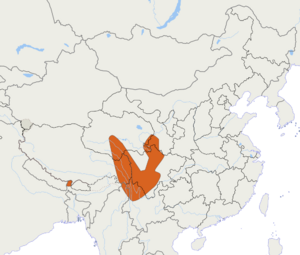Moupin pika facts for kids
Quick facts for kids Moupin pika |
|
|---|---|
| Conservation status | |
| Scientific classification | |
| Genus: |
Ochotona
|
| Species: |
thibetana
|
| Subspecies | |
|
|
 |
|
| Moupin pika range | |
| Synonyms | |
|
|
The Moupin pika (Ochotona thibetana) is a small, furry mammal. It is also known as the Moupin-pika or Manipuri pika. This animal is part of the pika family, called Ochotonidae.
Moupin pikas have different fur colors depending on the season. In summer, their fur is dark reddish-brown with some lighter spots on their back. Their belly is a yellowish-brown color. In winter, their fur becomes lighter, changing to a dull brown or yellowish-brown on their back.
These pikas eat many different kinds of plants. They live in the mountains of the eastern Tibetan Plateau. You can find them in parts of China (like Gansu, southern Qinghai, Yunnan, and Sichuan), Bhutan, India (Sikkim), and northern Myanmar.
Experts who study animals say the Moupin pika is a species of "least concern". This means it is not currently in danger of disappearing. However, one type of Moupin pika might be endangered.
Contents
Pika Family and Types
The Moupin pika was first described in 1871 by a French scientist named Alphonse Milne-Edwards. There are five main types, or subspecies, of the Moupin pika.
- Ochotona thibetana nangquenica
- Ochotona thibetana osgoodi
- Ochotona thibetana sacraria
- Ochotona thibetana sikimaria (This one might be a separate species!)
- Ochotona thibetana thibetana
Some pikas that were once thought to be Moupin pikas are now considered different species. For example, the Gansu pika and the Forrest's pika are now seen as their own distinct species. Scientists look at things like skull shapes and genetic information to decide if animals are different species. The O. t. sikimaria subspecies might be its own species because it lives in a different area and has unique genetic traits.
What Moupin Pikas Look Like
The Moupin pika is a fairly small animal. It measures about 14 to 18 cm (5.5 to 7.1 in) long. It weighs between 71 to 136 g (2.5 to 4.8 oz), which is about as much as a small apple.
Its skull is about 3.6 to 4.2 cm (1.4 to 1.7 in) long. The bones in its forehead are flat. The pika's ears are dark brown and measure about 1.7 to 2.3 cm (0.67 to 0.91 in) long. They have thin white edges. The bottom of their feet are covered in fur. Their back feet are about 2.4 to 3.2 cm (0.94 to 1.26 in) long.
As mentioned, their summer fur is dark reddish-brown on the back. Their belly is yellowish-brown. In winter, their fur on the back changes to a dull brown or yellowish-brown.
Where Moupin Pikas Live
Moupin pikas live in the mountains of the eastern Tibetan Plateau. This area includes parts of China, Bhutan, India, and northern Myanmar.
In China, they are found in Gansu, southern Qinghai, Yunnan, and Sichuan. One subspecies, O. t. sikimaria, lives in Sikkim, India. Another, O. t. osgoodi, is found in northeastern Myanmar.
They like to live in rocky areas. You can often find them under thick bushes like Rhododendron and in bamboo forests. They live at different heights in the mountains. While some are found as low as 1,800 meters (5,900 ft) above sea level, they prefer higher places. Most Moupin pikas live at elevations between 2,400 to 4,100 m (7,900 to 13,500 ft).
Behavior and Life Cycle
Moupin pikas are usually active during the day. However, they can also be active at night. They are social animals and live in groups, often digging burrows underground.
They are herbivores, meaning they eat only plants. They are known for collecting plants and drying them into "haypiles." They store these haypiles to eat later, especially during colder months.
The breeding season for Moupin pikas starts around April and lasts until July. A female pika can have one to five babies in each litter.
Status and Protecting Moupin Pikas
Since 1996, the Moupin pika has been listed as a species of "least concern" by the International Union for Conservation of Nature. This is good news because it means they are not currently facing a high risk of extinction. They are found across a wide area, and their numbers do not seem to be dropping quickly.
However, there are still some threats to Moupin pikas. One main threat is habitat destruction. This happens when their homes are damaged or removed. Small-scale cutting down of bamboo and Rhododendron forests can harm them. Also, too much grazing by farm animals can affect their habitat.
Because of habitat destruction, the Sikkim pika subspecies might be endangered. But other types of Moupin pikas seem to be safe for now. The Moupin pika lives in several protected areas. These include nature reserves like Changshanerhai, Jiuzhaigou, Nujiang, Wanglang, Wawushan, Wolong, and Zhumulangmafeng.
Even with these protected areas, cutting down forests in southern China could still be a problem for them. In some parts of India, they are very rare, and almost all of their habitat there has been destroyed. In southern Gansu, China, they are sometimes seen as pests.


